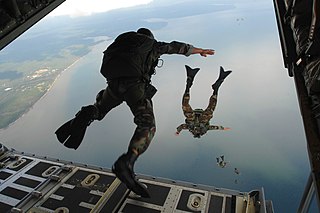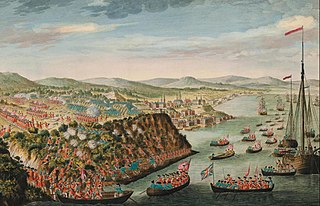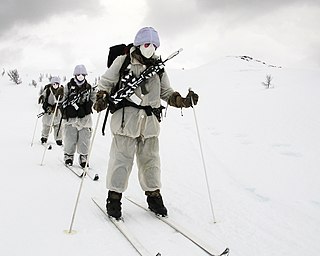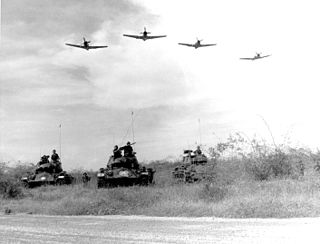 W
WAirborne forces are military units moved by aircraft and "dropped" into battle, typically by parachute, almost anywhere with little warning. Formations are limited only by the number and size of their aircraft; a huge force can appear "out of nowhere" behind enemy lines in minutes, an action known as vertical envelopment.
 W
WAmphibious warfare is a type of offensive military operation that today uses naval ships to project ground and air power onto a hostile or potentially hostile shore at a designated landing beach. Through history the operations were conducted using ship's boats as the primary method of delivering troops to shore. Since the Gallipoli Campaign, specialised watercraft were increasingly designed for landing troops, materiel and vehicles, including by landing craft and for insertion of commandos, by fast patrol boats, zodiacs and from mini-submersibles.
 W
WAnti-aircraft warfare or counter-air defence is defined by NATO as "all measures designed to nullify or reduce the effectiveness of hostile air action". It includes surface based, subsurface, and air-based weapon systems, associated sensor systems, command and control arrangements, and passive measures. It may be used to protect naval, ground, and air forces in any location. However, for most countries the main effort has tended to be homeland defence. NATO refers to airborne air defence as counter-air and naval air defence as anti-aircraft warfare. Missile defence is an extension of air defence, as are initiatives to adapt air defence to the task of intercepting any projectile in flight.
 W
WCold-weather warfare, also known as Arctic warfare or winter warfare, encompasses military operations affected by snow, ice, thawing conditions or cold, both on land and at sea. Cold-weather conditions occur year-round at high elevation or at high latitudes, and elsewhere materialise seasonally during the winter period. Mountain warfare often takes place in cold weather or on terrain that is affected by ice and snow, such as the Alps and the Himalayas. Historically, most such operations have been during winter in the Northern Hemisphere. Some have occurred above the Arctic Circle where snow, ice and cold may occur throughout the year. At times, cold or its aftermath—thaw—has been a decisive factor in the failure of a campaign, as with French invasion of Russia in 1812, the Soviet invasion of Finland in 1939, and the German invasion of the Soviet Union during World War II.
 W
WChampion warfare refers to a type of battle, most commonly found in the epic poetry and myth of ancient history, in which the outcome of the conflict is determined by single combat, an individual duel between the best soldiers ("champions") from each opposing army. Champion warfare can also refer to a battle in which armies actually engage, but champions within the armies fight so effectively as to single-handedly carry the sway of battle, such as in the Iliad.
 W
WCombined arms is an approach to warfare which seeks to integrate different combat arms of a military to achieve mutually complementary effects. According to strategist William S. Lind, combined arms can be distinguished from the concept of "supporting arms" as follows:Combined arms hits the enemy with two or more arms simultaneously in such a manner that the actions he must take to defend himself from one make him more vulnerable to another. In contrast, supporting arms is hitting the enemy with two or more arms in sequence, or if simultaneously, then in such combination that the actions the enemy must take to defend himself from one also defends himself from the other(s).
 W
WA counter-insurgency or counterinsurgency (COIN) is defined by the United States Department of State as "comprehensive civilian and military efforts taken to simultaneously defeat and contain insurgency and address its root causes".
 W
WEndemic warfare is a state of continual or frequent warfare, such as is found in some tribal societies.
 W
WExpeditionary warfare is the deployment of a state's military to fight abroad, especially away from established bases. Expeditionary forces were in part the antecedent of the modern concept of quick reaction-rapid deployment forces. Traditionally, expeditionary forces were essentially self-sustaining with an organic logistics capability and with a full array of supporting arms.
 W
WThe flexible defense is a military theory about the design of modern fortifications. The examples of "flexible" defense-lines are not based on dense lines of heavily armed, large and expensive concrete fortifications as the systems such as the Maginot Line were. Their protective capacity hinges on multiple lines of obstacles and small shelters fitting into the environment. They are "flexible" because soldiers are not locked in pillboxes, but fight instead in easily replaceable open earth-wood maden positions, while bunkers serve only as shelters during bombardments. As a result, they are able to adapt to the opponent's movements, and there are no easily targeted large buildings in these lines.
 W
WGuerrilla warfare is a form of irregular warfare in which small groups of combatants, such as paramilitary personnel, armed civilians, or irregulars, use military tactics including ambushes, sabotage, raids, petty warfare, hit-and-run tactics, and mobility, to fight a larger and less-mobile traditional military.
 W
WA low-intensity conflict (LIC) is a military conflict, usually localised, between two or more state or non-state groups which is below the intensity of conventional war. It involves the state's use of military forces applied selectively and with restraint to enforce compliance with its policies or objectives.
 W
WMard ō mard was an ancient Iranian tradition of single combat, the Sasanian Empire being most known for using it. During a battle, the Sasanian troops would use taunts and war cries to provoke the enemy into a single duel with a Sasanian champion. The tradition meant much to the Sasanians—in 421, during Bahram V's war against the Romans in 421–422, Ardazanes, a member of the "Immortals", was in a single duel killed by the Roman comes Areobindus, which contributed to Bahram V's acceptance of the defeat in the war and making peace with the Romans.
 W
WThe concept of networked swarming warfare was first proposed by HUO Dajun in 2003. The key feature of the information age is the networking of organizational structure. The rising networked organization will overcome the limitation of traditional geography and link the operational resources distributed widely to form a military action network which combine strike range, speed and lethality, three elements of originally different developing, fundamentally transforming our idea of battle space. With the trend of decentralization of forces, we need to develop more small units with independent combat functions; meanwhile we can join these small units into a whole network as the technology's development. The warfare based on this network is called networked swarming warfare.
 W
WPolitical warfare is the use of political means to compel an opponent to do one's will, based on hostile intent. The term political describes the calculated interaction between a government and a target audience, including another state's government, military, and/or general population. Governments use a variety of techniques to coerce certain actions, thereby gaining relative advantage over an opponent. The techniques include propaganda and psychological operations (PSYOP), which service national and military objectives respectively. Propaganda has many aspects and a hostile and coercive political purpose. Psychological operations are for strategic and tactical military objectives and may be intended for hostile military and civilian populations.
 W
WA proxy war is an armed conflict between two states or non-state actors which act on the instigation or on behalf of other parties that are not directly involved in the hostilities. In order for a conflict to be considered a proxy war, there must be a direct, long-term relationship between external actors and the belligerents involved. The aforementioned relationship usually takes the form of funding, military training, arms, or other forms of material assistance which assist a belligerent party in sustaining its war effort.
 W
WRadiological warfare is any form of warfare involving deliberate radiation poisoning or contamination of an area with radiological sources.
 W
WNot to be confused with the cultural component of the war - the processes of confrontation between Russia and Ukraine in the cultural sphere.
 W
WSpecial forces and special operations forces (SOF) are military units trained to conduct special operations. NATO has defined special operations as "military activities conducted by specially designated, organized, trained, and equipped forces, manned with selected personnel, using unconventional tactics, techniques, and modes of employment".
 W
WSubmarine warfare is one of the four divisions of underwater warfare, the others being anti-submarine warfare, mine warfare and mine countermeasures.
 W
WTerrorism is, in the broadest sense, the use of intentional violence for political or religious purposes. It is used in this regard primarily to refer to violence during peacetime or in the context of war against non-combatants. The terms "terrorist" and "terrorism" originated during the French Revolution of the late 18th century but gained mainstream popularity in the 1970s during the conflicts of Northern Ireland, the Basque Country and Palestine. The increased use of suicide attacks from the 1980s onwards was typified by the September 11 attacks in New York City and Washington, D.C. in 2001.
 W
WTrench warfare is a type of land warfare using occupied fighting lines largely comprising military trenches, in which troops are well-protected from the enemy's small arms fire and are substantially sheltered from artillery. Trench warfare lasting for several years took place on the Western Front in World War I. Following that war, "trench warfare" became a byword for stalemate, attrition, sieges, and futility in conflict.
 W
WAccording to military terminology, a two-front war occurs, when opposing forces encounter on two geographically separate fronts. The forces of two or more allied parties usually simultaneously engage an opponent in order to increase their chances of success. The opponent consequently encounters severe logistic difficulties as he is forced to divide and disperse his troops, defend an extended front line and is at least partly cut off from access to trade and exterior resources. However, by virtue of the central position he might possess the advantages of the interior lines.